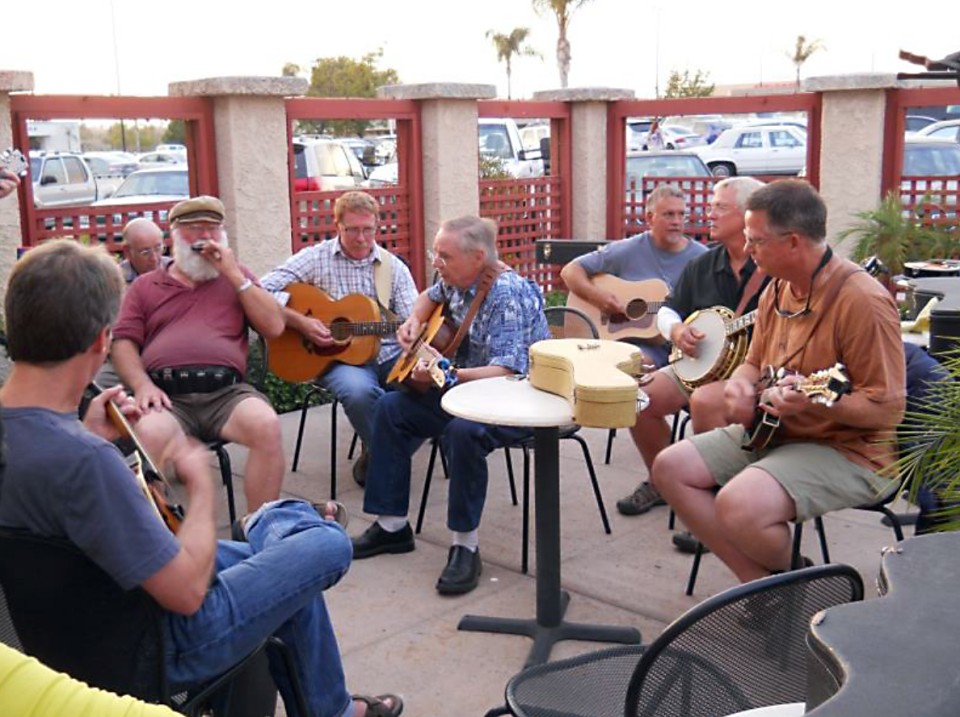
A bluegrass jam circle.
The approach. If you see a group jamming, listen a bit and see if you might fit in. Are they playing at your level? Will your instrument and voice contribute? Make sure it’s not a band rehearsing but is actually a jam session!
The Entry. Wait until a song ends and then ask if you can join. This is courteous to the group and politely lets them know you want to participate. Asking will help you get a turn when things come around to you (read on!). But, if you are unsure or unsteady, it is also okay to stay in the background, play along quietly, skip solos and singing, and learn.
Basic Jam Etiquette. Players and singers stand or sit in a circle where they can hear each other. One person calls a tune and its key, and then leads that song. Solos are passed around the group in order. Be ready! If you want to play a solo make eye contact with the song leader to let them know. Then, start your solo when it is your turn. You are not required to take a solo, and it is perfectly fine to pass. BUT, let the person next to you know you are passing BEFORE the tune gets to you. This allows the next person to start a solo on time.
What to Play? Think ahead. What can you play or sing competently that is easy and well known? The idea is to pick something the group will know and be able to join in. That obscure tune with all those complicated chords is probably not your best choice! My advice: have three well known bluegrass standards ready to go in comfortable keys you can play, and where you know all the lyrics.
How to Lead. When it comes to your turn, announce the tune you want to play and what the key is. For example, “Let’s play ‘In the Pines’ in the key of G.” Think ahead about the kick off. If you can do it, go for it. If you prefer that someone else do the kick off, that’s fine, just ask “Joe can you do a banjo kick off for me?” Remember, the kickoff is to alert the group of the tempo you have chosen and where to start, so make it strong and clear. Playing the last phrase of the chorus is often a good kick off.
Guiding the Tune Around the Circle. Once the tune is going, it is your responsibility to guide it through the group. Eye contact or a point will usually do as to who is next. Generally, the group will have an established “around the horn” order. But, for example, if two banjo players are standing next to each other, you might want to call for mandolin or fiddle in between, and that kind of change is your call. Bass solos are not common, but it is polite to ask.
A Turn for Everyone. Make sure everyone who wants a solo turn is offered one, and look for eye contact to know who is going to pass, so you can skip them. Solos are appropriate between verses on a singing song. So, plan ahead here, too. For example, if there are three verses in your tune and six players, you need to accommodate two solos per interval to give everyone a chance. If your tune is an instrumental, the etiquette is that each person plays it through once.
Ending Your Tune. The etiquette is for the tune to come back to you as the last player and you play/sing a final verse or chorus and play an end. Endings can be “crash” where you just stop on the final note. Or, more commonly, you sing or play the last phrase a second time. If this is your plan, wave your arm above your head in a circle to indicate there will be a repeat at the end.
WHAT TO DO AND WHAT NOT TO DO
What to do
What not to do
ERRATA
Choosing the Key. The etiquette is that a song is played in the key that the lead singer prefers. So, if you play “Little Cabin Home” in G and the singer wants to do it in A, you do it in A.
Singing. If you call a singing tune, it is perfectly fine to sing all of it yourself. If you would like to have harmony accompaniment, ask for it before you start. If you want to sing harmony, ask before jumping in.
Have fun! This is the most important part.
Next month we’ll review a rundown of where to find great bluegrass jamming in San Diego.

